DARIUS THE GREAT, Part II - Expanding an Empire
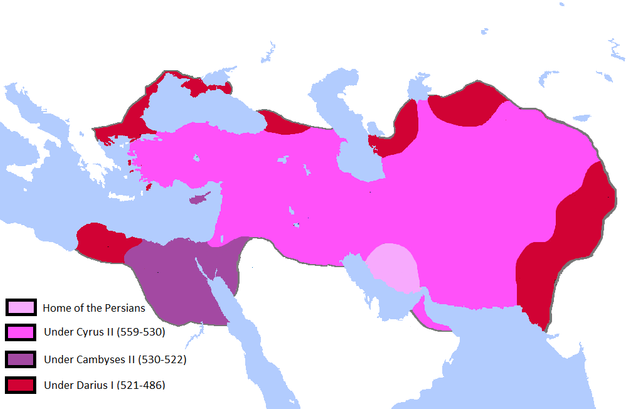
[ABOVE: The expansion of the Achaemenid Persian Empire under Darius I (red)]
Go and check out my other blog on Darius the Great consolidating his empire:
https://steemit.com/hive-133974/@oo7harv/darius-the-great-part-i-administrating-an-empire
Like Cyrus, Darius was not just a brilliant ruler, but an equally brilliant conqueror. Under his reign, the Achaemenid Persian Empire would reach its territorial height, with borders stretching from Greece and Libya in the West to Central Asia and India in the East.
Under his reign, the regions of the world including the Greek islands, Scythia, Libya and mainland Europe would come under his fold, and a large revolt would be suppressed, and I will discuss these conquests now.
THE CAPTURE OF SAMOS
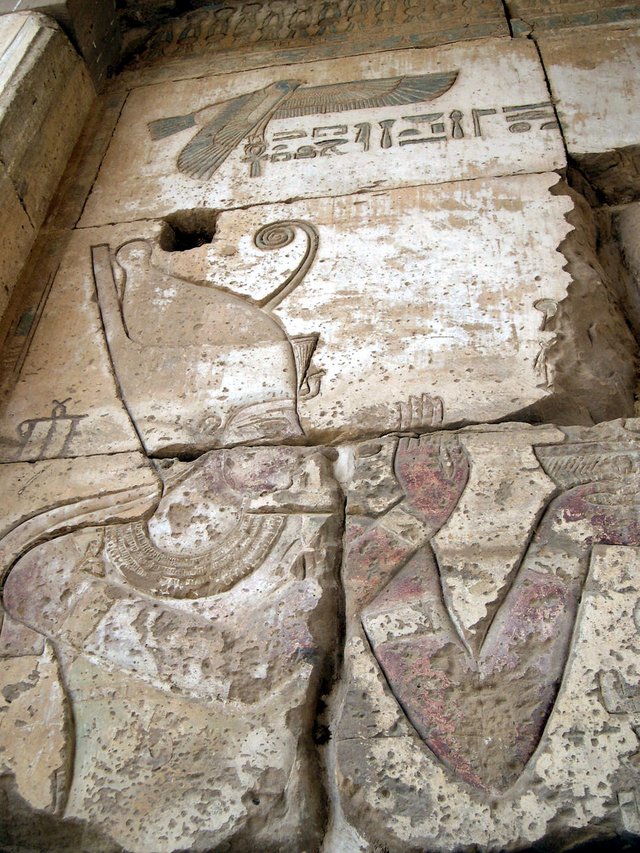
[ABOVE: Darius the Great, depicted as Pharaoh of Egypt at the Temple of Hibis]
With ease, Darius conquered India up to the Indus Valley, and quelled a revolt in Egypt again, stabilising Persian rule there for now. The first place West that Darius went to conquer was the island nation of Samos.
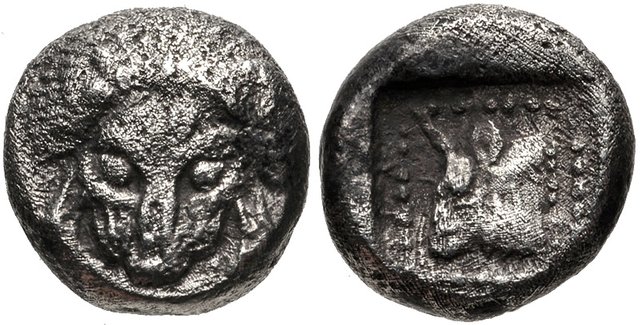
[ABOVE: Minted coins from Samos at the time of Syloson, c.500 - 494 BC]
During King Cambyses’ reign in Egypt, large numbers of Greeks came to Egypt for varying reasons, one man of which was Syloson, Polycrates’ brother, who had been exiled from Samos. While walking the streets of Memphis, Darius (who at the time was an un-noteworthy figure in Cambyses’ personal guard) saw Syloson wearing a red cloak that he wanted. Darius approached Syloson offering to buy it, and seeing how anxious Darius was to get the cloak, Syloson said that he wouldn’t sell the cloak for any amount of money, but would give it away for free if it was wanted that badly, and thus gave Darius the red cloak. After the Conspiracy of the Seven and Darius’ accent to power, Syloson went to Susa to meet Darius. Syloson waited outside the palace gates and claimed to the guards to be a benefactor to Darius. Unaware of who was approaching him, Darius sent for the man to be brought to his presence. Darius was reminded of him getting the red cloak by Syloson, and the king showed his gratitude and offered to reward him for it at last. However, instead of wanting gold or silver, Syloson requested his homeland of Samos back; since Oroetes had Polycrates killed, the nation had been in the hands of the Greek's slaves. Syloson wanted his home back, but without a drop of blood being spilt.
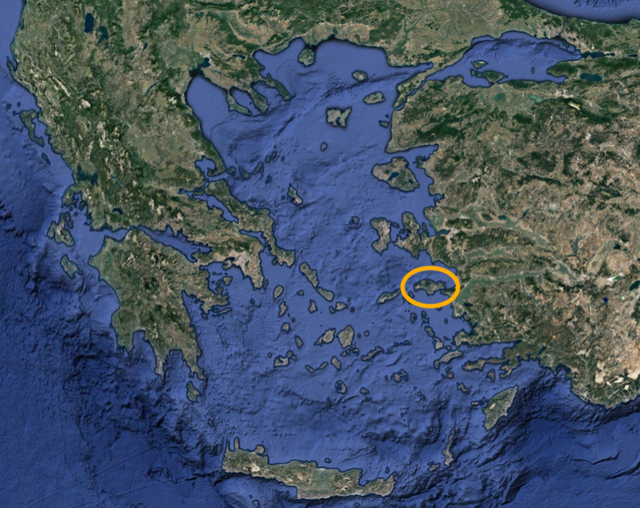
[ABOVE: A map of the Aegean Sea, highlighting the island of Samos]
Darius organised an expedition to Samos under the command of Otanes, one of the Seven Conspirators. Darius told Otanes to do whatever Syloson asked of him. The man now in power of Samos was Maeandrius, the son of Maeandrius; Upon learning of Polycrates’ death, Maeandrius ordered an altar to Zeus be built with a boundary around it at the edge of town. He then addressed the citizen body, telling them that power had been entrusted to him to rule over them, stating that he wished to be a more fair and equal ruler, claiming only a sum of money from Polycrates to himself and priesthoods to Zeus for his own family. A man of some prestige from the crowd, Telesarchus, rose up however, stating that Maeandrius didn’t deserve to be in charge as he was low-born, and also wanted an account for the money Maeandrius was now handling. Maeandrius thought that if he gave up his power now, someone else would simply become tyrant. Withdrawing to the acropolis, he sent for the people to be brought to him one at a time as if he were going to financially reward them, but instead had them imprisoned. While the people were imprisoned, Maeandrius fell ill. Lycaretus, his brother who also wanted power for himself, had all the prisoners killed, as allegedly they did not want to be freed.
This is all key to know because when the Persians under Otanes landed at Samos, the citizens left on the island did not object to the idea of someone else ruling over them. Maeandrius and a handful of his supporters readied to leave the island under a truce with Otanes. During the truce-making, Persian officials heard Charilaus, Maeandrius’s imprisoned and insane brother, call out to them, asking to see his brother. Once brought to Maeandrius, Charilaus argued that while he had been imprisoned by his own brother, Maeandrius was willing to exile himself in favour of his homeland succumbing to foreign rule, and Charilaus called him a coward for it. Charilaus asked Maeandrius to give him some mercenaries if he was just afraid of the Persians, stating he would make them regret ever coming to Samos and that he would be happy to help his brother get off the island all the same. Maeandrius agreed to the plan. It’s likely not because Maeandrius thought Charilaus could defeat the Persians, but rather because he resented the lack of effort in Syloson’s coming recovery of an intact town; should the Persians be poorly treated, Samos could come to meet a bad fate by their hands, and thus he likely wished to hand the island over to the Persians in a poor state.
Maeandrius thus left Samos, and Chailaus’s mercenaries took the Persian nobles by complete surprise and killed them. This act brought the rest of the Persian expeditionary army down to the scene, where they later pinned the mercenaries on the acropolis. Otanes ignored Darius’s order to take the island without bloodshed; Otanes handed the island over to Syloson in good condition, and told his men to kill any adult and child they came across.
Maeandrius meanwhile sailed to Sparta with his belongings and personal riches. While there, he would frequently set out silver and gold goblets on a table and have servants polish them while he spoke to the Spartan king, Cleomenes, attempting to bring him into his home. As Cleomenes would be in awe at the riches he saw in his home, Maeandrius would offer Cleomenes to take as many as he pleased, yet after hearing this offer three times over, Cleomenes rejected them, fearing the wealth could corrupt his Spartan people. Maeandrius was soon asked to leave the Peloponnese.
THE RECONQUEST OF BABYLON
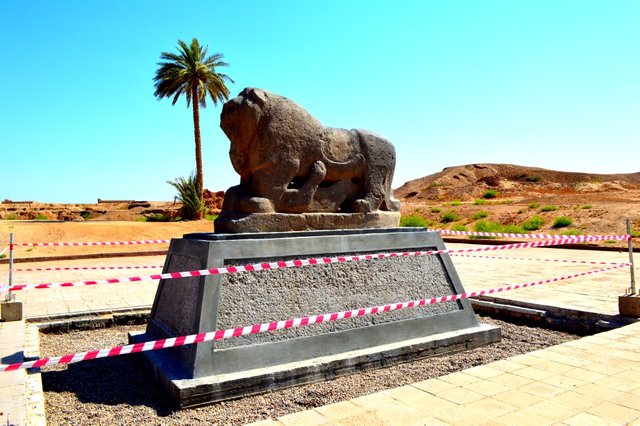
[ABOVE: A lion statue, once positioned in the centre of the city of Babylon. The lion itself is an original, but the base is a cement reconstruction, built June/July 2013]
During the Samos expedition, Babylon revolted. During the entire Magi Revolt and the Conspiracy of the Seven, they had readied themselves for a siege and had gone unnoticed in the process. Once the rebellion was in the open, the men of the city gathered most of the city’s women and publicly strangled them. Other women who were allowed to live, chosen either because they were mothers or just chosen by individual men to live, were kept alive as cooks. Once Darius got word of the rebellion, he gathered a large army to meet them, besieging the city as soon as his forces reached the walls, yet the citizens remained unthreatened, and its people would often taunt the Persian king during the siege, with one man shouting out, “What are you doing sitting there, men of Persia? Why don’t you just go away? Babylon will fall into your hands only when mules start bearing young!”, which they believed would never happen.
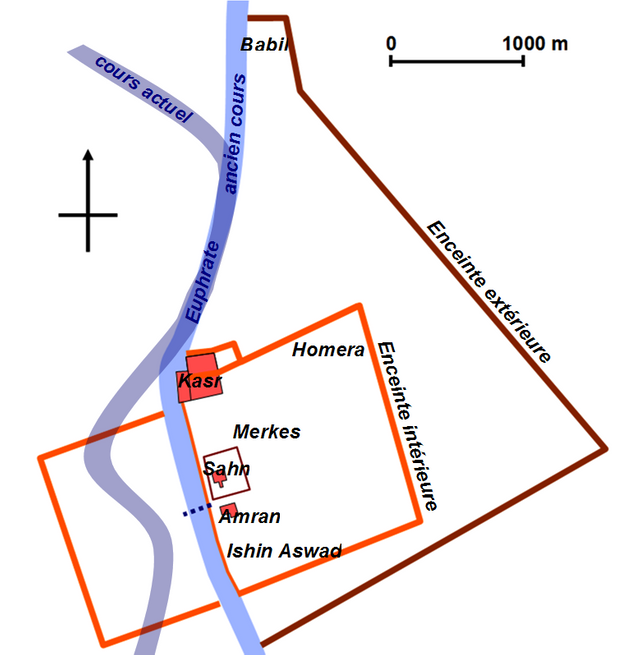
[ABOVE: A plan view of ancient Babylon along the ancient banks of the Euphrates River, with the city walls marked in orange and brown]
Despite using every trick to try and reclaim the city, including the same method that Cyrus used to capture the city for Persia in the first place, the city remained untaken for a year and seven months. It was in the siege’s twentieth month that Zopyrus, the son of Megabyzus (one of the Seven Conspirators), was told of one of his pack-mules giving birth. He took this as a sign that Persia could indeed recapture the city, thinking that God must have guided the Babylonian man to shout what he shouted, and guided the mule to give birth. Once asking and finding out from Darius just how important the recapture of Babylon was to him, he set to work; he cut off his own nose and ears, flogged himself and gave himself a rough shave. His plan was to “defect” to the Babylonians and appear as if he had been poorly treated under Persian rule. Shocked at the sight of Zopyrus, Darius was convinced by him that once he was taken in to Babylon, the Babylonians would grant him military command; he planned first to approach the city as a deserter, claiming Darius mutilated him, and, as a man of his prestige, he would gain some military command within the city. Darius was then to post more expendable soldiers, armed only with daggers, at each of the city’s gates over the course of several days. Once these soldiers were inevitably beaten back, Zopyrus would be rewarded with the Babylonian’s confidence, and hopefully the keys to the city gates. Thankfully for Darius, the plan played out perfectly; the gates were swung open mid-siege and several thousand city defenders were slaughtered.
With Babylon back under his hold, Darius ordered the city walls and gates to be torn down, an act which Cyrus himself was never able to do, and he ordered around 3,000 Babylonian men to be impaled on spikes. However, even after all of that, the city was returned to the Babylonians. With the remaining citizens there not having many women left since a majority of them were strangled, Darius ordered all nearby peoples to send some women to the city. In total, around 50,000 women arrived in Babylon. In Darius’s mind, no one had performed such a great act as Zopyrus, except Cyrus, saying he would rather see Zopyrus remain notmutilated than see him help capture twenty Babylons. Zopyrus was rewarded with gifts, his own domain and a tax-free life.
THE SCYTHIAN CAMPAIGN
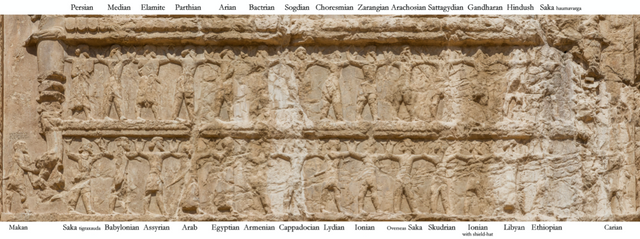
[ABOVE: The Tomb of Darius, depicting his army's several ethnicities]
Following the fall of Babylon, Darius set his eyes on the steppes of Eurasia towards the nomadic Scythian tribes. Their nomadic lifestyle meant they had no settled towns or cities, but instead carried their livelihoods and livestock around with them on the move, constantly settling down temporary living areas. Since their specialisation in warfare lay with horse archery and since their primary means of acquiring food was cattle and not agriculture, this suited them perfectly. While not abundant in notable or large natural features, two things the steppes were known for were the number of rivers within its boundaries and the sheer size of the flat landmass.
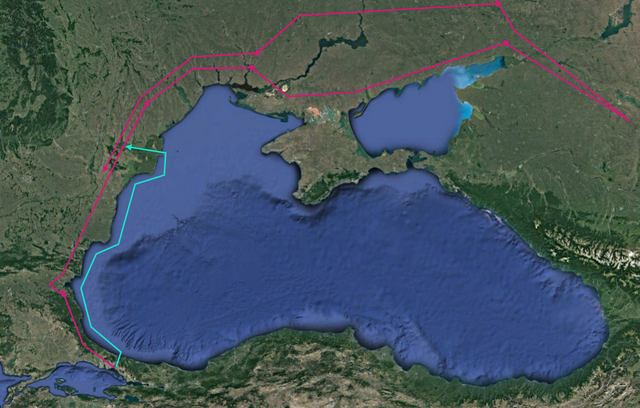
[ABOVE: A map of Darius's Scythian campaign. Darius's route is shown in purple, while his Ionian fleet's route is shown in cyan, with both meeting at the River Ister]
DARIUS'S MARCH FROM SUSA TO THE RIVER DANUBE
Darius sent messengers all across his empire to ready for the invasion, ordering for the gathering of ships and soldiers to cross the Bosporus into Thrace. His march to Scythia began in Susa, and upon reaching the coastal city of Chalcedon (now in the city of Istanbul), he and his army crossed a bridge which had previously been prepared for this expedition. After gazing at the beauty of the Black Sea from his ship, he sailed back to the bridge. After also inspecting the Bosporus too, he erected 2 pillars, having them list all the peoples he was bringing over into Europe. According to Herodotus, this number, which included cavalry, numbered 700,000, while the fleet numbered 600 ships, but these high numbers are disputed today. Darius would either way reward the bridge’s engineer, Mandrocles of Samos, with gifts for allowing such a potentially vast army to easily cross into Europe. Mandrocles would later thank Darius for such rewards by the creation of a painting depicting Darius and his forces crossing the Bosporus. The art was kept at the temple of Hera with the following inscription:
"This painting Mandrocles dedicated to Hera, to commemorate
His bridging of the fish-rich Bosporus with a pontoon;
His feat won the approval of King Darius,
And earned a crown for himself and glory for the Samians.
Upon crossing the Bosporus, Darius ordered his Ionians to take the navy into the Black Sea and up the River Ister, bridge it and await their king for further instructions. Meanwhile, Darius advanced through Thrace, until reaching the River Tearus where he made camp for 3 days. Liking the river, and hearing that the locals alleged it had various healing abilities, Darius erected a pillar here too, ordering the following inscription be detailed on it:
"There is no better or finer water in the world than that of the springs of the River Tearus. And to them there came, leading an army against the Scythians, the best and finest man in the world, Darius the son of Hystaspes, king of Persia and the whole continent."
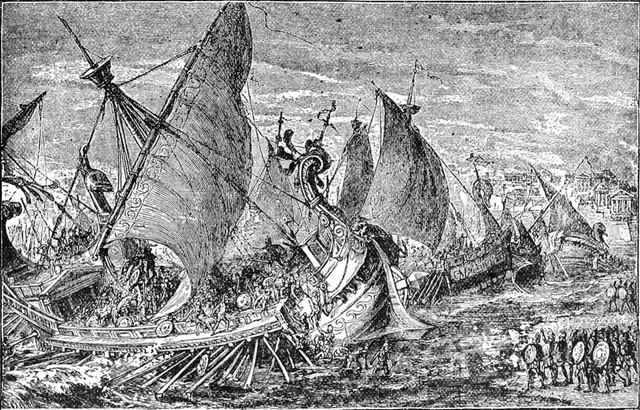
[ABOVE: Junction of the Ionian fleet and Darius's Persian army at the Bosporus, by Jacob Abbott, 19th century]
Darius conquered all Thracian and Dacian peoples he encountered, including the Getae, before reaching the River Ister. Crossing it, he ordered his Ionians to dismantle the bridge and join up again with his forces, however an eminent man named Coës advised the king to leave the bridge up and keep it guarded, since Darius was about to invade lands where agriculture and thus permanent settlements were not known, and their random nomadic nature would make them hard to track down and thus conquer. Thankful for the advice, Darius instead ordered 60 knots to be tied to a leather strap, and told his Ionians to stay behind, guard the bridge and untie one knot every day that Darius’s main force was in Scythia. Should he not return on the 60th day, the Ionians were free to go back home.
SCYTHIAN DEFENCE PLAN
It didn’t take long for the peoples of Scythia to get word of such a large, foreign invasion. They agreed that a straight fight against the Persians would end terribly for them, so instead gathered several tribes to convene together as one. While convening, a messenger arrived, who told them of how Darius already had control of the Asian continent and had bridged all rivers up to Scythian lands, warning them not to stand by idly while such a vast force approached. Views were split as to what to do; some Scythian tribes had already attacked Persian forces and thus in their mind provoked the Persians to attack full-scale, but only those who had provoked him in the first place. Eventually, they agreed to not fight against the Persians in open conflict, but instead retreat. While they retreated though, they would fill in springs and wells, and destroy all vegetation they came across. The Scythian forces were also to be split into 2; one, led by Scopasis, was ordered to pull back to Lake Maeetis and to the River Tanaïs, but if Darius withdrew from them instead, they were to attack him. The other division, led by Idanthyrsus and Taxacis, were also ordered to withdraw and keep a day’s march between themselves and the Persians. They were ordered to withdraw further, if necessary, towards the lands of the Scythians who had refused to fight to hopefully goad them into combat with them.
THE CAMPAIGN
spaced forts. While these were under construction, the Scythians Darius was pursuing circled back into Scythia by a northern route, completely disappearing. Once his forces lost complete sight of the Scythians, Darius abandoned the fort’s completion and turned west, believing the Scythians had gone that way.
After a forced-march, Darius arrived back in Scythia and came face to face with the combined forces of the other Scythian detachments, who kept their day’s march ahead of the invaders. As Darius did not break off from his pursuit of them, the Scythian detachment kept up their retreat into the lands of those other Scythians who had refused to help fight. This constant retreat into the lands of those who were not fighting stirred up a lot of confusion in their homelands, forcing many of them to flee their lands. One Scythian peoples though, the Agathyrsians, seeing how everyone else had fled due to confusion, sent a messenger to the withdrawing Scythian detachment. The messenger warned the army not to cross into their lands under threat of being attacked, and the Agathyrsians sent men to defend their borders. Seeing this well-prepared defence, the Scythian detachment led the Persians back into Scythia.
This chase was testing Darius’s patience. He thus sent a messenger to Idasthyrsus asking why his men were constantly withdrawing if they fought themselves so capable of fighting back. He asked the Scythian king that if, on the contrary, he thought his own forces weaker than his Persian army, then peace terms should be discussed, and Darius should be recognised as their master with the typical offer of “Earth and water”. Idasthyrsus replied that he had never fled from an enemy out of fear; since he had no settled towns to protect. He could keep moving as he pleased, and told Darius’s messenger that he may only consider attacking should his ancestral burial grounds be attacked. Until then, the only masters he bowed down to were the deities Zeus and Hestia, Queen of Scythians.
The mention of potential enslavement infuriated the Scythians. Scopasis, leading the first Scythian division, was sent to talk to the Ionians guarding the bridge, while the rest of the Scythian forces were to halt their constant retreats and attack the Persians while they stopped to look for food. The Scythians kept up a constant “attack and retreat” policy, pulling back from raiding the Persian army when the more tightly-packed infantry came to repel them. These assaults were kept up even at night, putting a constant strain on the Persian forces. However, one thing that slightly halted the Scythian attacks was the sound of mules; these animals were not native to Scythian lands due to the lower temperatures, and so the unfamiliar sound of donkeys threw the Scythian horses, comprising most of the Scythian army, into confusion and disarray. But either way, the attacks persisted and constantly weakened and worried the Persians.
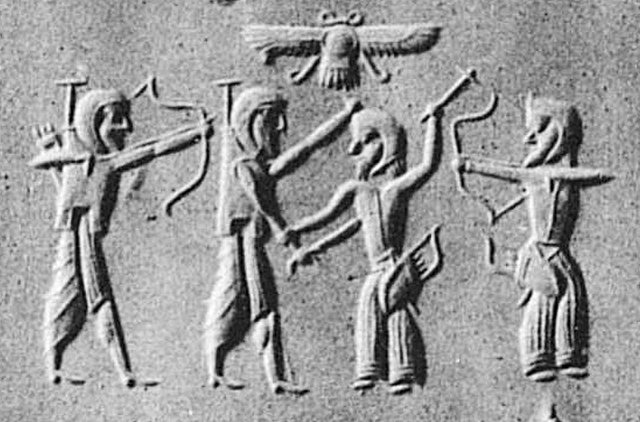
[ABOVE: Persian infantry fighting Scythians, depicted on a Persian cylinder seal]
Knowing this, the Scythians wished to prolong the Persians’ stay in their lands, in the hope that it would shorten their supplies to make them wish they’d never stayed; the Scythians began to leave some of their livestock and supplies behind on their marches and allow the Persians to take them, boosting their morale. When this had happened enough times, events started to head south for Darius. He soon received a gift from a messenger without explanation: a bird, frog, mouse, and five arrows. All Darius was told was that if he were smart enough, he’d figure it out. Darius interpreted the gifts as the equivalent of an “Earth and Water” submission, whereas Gobryas interpreted the gifts as a sign that they should burrow, swim or fly away (like a mouse, frog and bird respectively) before being shot down by arrows. While the Persians decided what this meant, the first Scythian division, originally tasked with pulling back to Lake Meets, reached the bridge over the River Ister. They discussed with the Ionians that they knew of their task to guard the bridge for 60 days and leave if Darius didn’t return in the meantime, before heading back into Scythia.
Once Darius took the gifts, the Scythians who remained in Scythia organised into battle formations and approached the Persians. While waiting in battle lines, a hare sprinted across the field between the two armies, and the Scythians weirdly gave chase to it one after another. Confused, Darius took this event as a sign that Gobryas was right, thinking the Scythians were holding the Persians in contempt, stating that the best plan now was to return to Persia. Gobryas too said that the best thing to do now was leave the mules and weakest troops behind and retreat back to the Ister. Come morning, Darius followed Gobryas’s plan. The Persian soldiers left behind were told by Darius that they were there to distract the Scythians while Darius found a path to flank them on. Eventually realising they had been betrayed by their king, this Persian detachment joined with the Scythians into one large army.
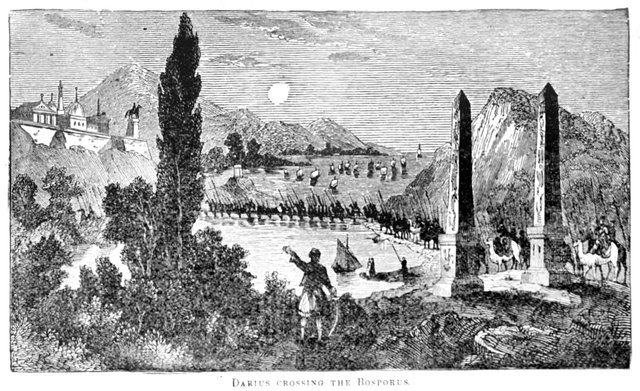
[ABOVE: Darius crossing the Bosporus again, by Jacob Abbott, 19th century]
Now the Persians, not knowing the exact way back, were on foot fleeing from a native army of faster horse riders, and as a result the Scythians reached the Ister before the Persians. They spoke to the Ionians again and told them that their 60 days were up, encouraging them to dismantle the bridge and leave them to deal with Darius in Scythia. Among the Ionians was the tyrant of the Hellespontine Chersonese, Miltiades of Athens. He argued that the Scythian’s words were wisest and wanted to abandon the bridge, whereas another commander, Histiaeus of Miletus, argued that were it not for Darius, he would not be allowed his rule over Miletus and thus argued that they should stay. This swung the Ionian soldiers’ opinion to side with Histiaeus; many among them were also tyrants held in high regard by the Persian king. Wanting to make their actions match their words for Darius, they started to dismantle enough of the bridge to keep them safe from arrow fire and to make it seem like they were helping the Scythians, thus stalling the Scythians’ attempt to breach the bridge while they waited for Darius. Histiaeus, quickly elected as a representative to the Scythians, told the Scythians to find and ambush the Persians while they “dismantled” the bridge, however their previous plan of destroying their own lands to weaken the Persians before backfired and made it harder to track them. This slow and careful march allowed by the Scythians allowed the Persian army to make it back to the Ister. The bridge was then reconstructed and Persian soldiers were ferried back over the river. The rest of the Persian army returned home safely.
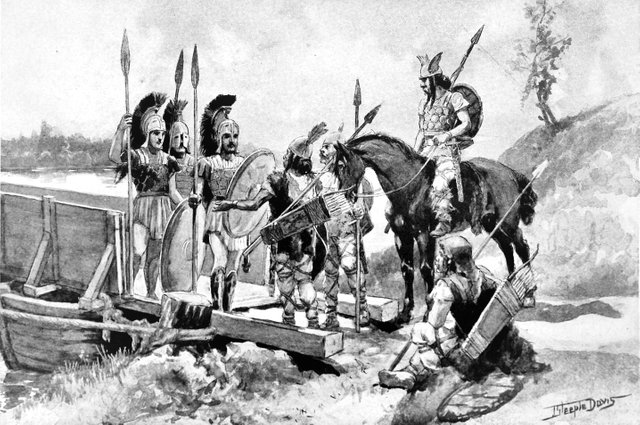
[ABOVE: Histiaeus and his Greeks holding the bridge for Darius, by John Steeple Davis, 19th century]
The Scythians would after refer to Ionian Greeks as “the worst and most cowardly free people in the world”, yet stated that if they ever became slaves, they would be loyal. Megabazus was left in charge of the Hellespont forces in Europe, supposedly numbering 80,000 men.
THE LIBYAN CAMPAIGN
This one's a short one, but worth a mention.
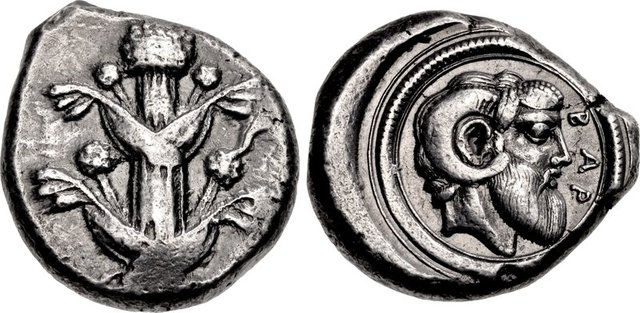
[ABOVE: Coin minted at Barca, under Persian rule, c.475 - 435 BC]
Before the march into Europe and, ultimately, Greece, the last main campaign the Persians undertook was in Libya. The city of Barca was besieged for 9 months, and it was aggressive; tunnels were repeatedly dug underground as a means to pass the walls of the city under cover. As clever as this may have been, a metalworker in the city actually managed to detect the tunnels by holding a bronze shield against the grounds inside the city wall. He held the shield against the ground and gave it a bash; where there was a tunnel, the shield gave off a ringing sound, and where there was no tunnel, the shield gave off virtually no sound. Counter-tunnels were thus dug to meet the Persians, and the attacks were repelled. The direct assaults on the city walls were also unsuccessful, and the Barcaeans repelled the attacks for all this time.
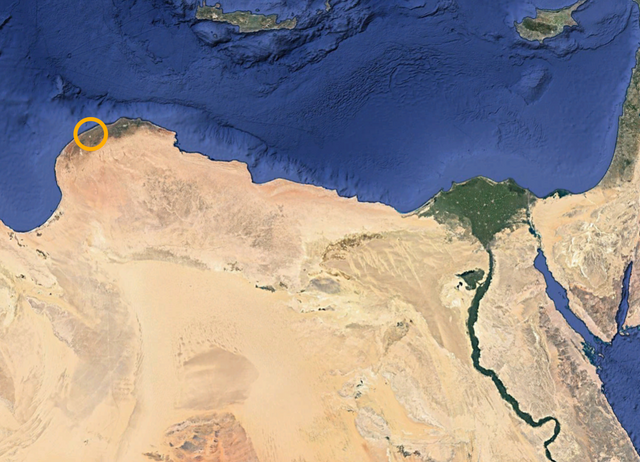
[ABOVE: The city of Barca in Libya, south-west of Cyrene]
Commanding the Persian forces was Amasis - not the former Pharaoh. He realised the city would not fall to brute strength, so instead came up with a plan; at night, he ordered for his army to dig a wide trench and lay weak wooden planks on top of it, and then cover the wood with soil until level with the rest of the ground. By morning, the Barcaeans were invited to meet with the Persians, and they happily agreed. The meeting concluded with both sides agreeing to come to terms “as long as this earth lasts”, while the Barcaeans agreed to pay tribute to the Persians in the meantime. The city gates were then flung open to allow the Persians to come inside the city at will, and it was at this moment that the wooden planks were ordered to be broken. The Persians made their way into the city and, per the “lasting earth” agreement, the truce was broken. Large numbers of they city’s population was slaughtered and sold into slavery.
The Persians, now heading back to Egypt, made their way to the Greek colonial city of Cyrene. The people there though had been directed by an Oracle to let the Persians pass through freely, although I wonder if their quick allowance of Persian passage had anything to do with how the people of Barca were recently treated. Badres, commander of the Persian fleet, insisted that this was the perfect opportunity to occupy the city, but Amasis insisted otherwise; this was not the city they had come to conquer. They would later attempt to retake the city, but to no success. The enslaved Barcaeans were sent to Darius, who allowed them to found their own settlement in Bactria, and they of course named this new city “Barca”.
EUROPEAN CAMPAIGNS
MEGABAZUS IN THRACE
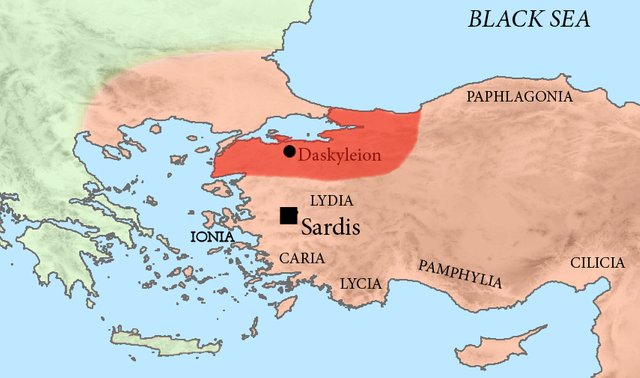
[ABOVE: Megabazus's Satrapy of Hellespontine Phrygia]
Following the retreat from Scythia, Megabazus was left in charge of the Hellespont to subdue Thrace. Thrace was one of the most highly populated regions in the world at the time. According to Herodotus, only Indians outnumbered Thracians, and any man who could solely rule Thrace would be ruling over the most powerful nation on Earth, and they themselves would be invincible. The first city to fall to Megabazus was Perinthus, because the citizens refused to acknowledge Darius as their ruler. Perinthus had recently been ravaged by an assault by Paeonians from the north, and they had severely depopulated the city. The people of Perinthus thus saw it as their duty now to preserve their independence and freedom and defend their city at all costs, including from the Persians. Severely outnumbered now though, they fell to the empire with ease. Following Perinthus, all cities Megabazus reached fell to him with ease, as that was Darius’s command: Conquer Thrace.
DARIUS IN SARDIS
While Megabazus was in Thrace, Darius returned to Sardis. There, he allowed Histiaeus, who commanded the Ionians in Scythia, to return as tyrant of Miletus, as well as granting him the same position over Myrcinus in Edina. He also gave Coës, the commoner who had advised Darius’s Ionian forces in Scythia to wait 60 days by the Ister River, the position as tyrant of Mytilene. It was then that Darius noticed something that made him want to round up the Perennials in Europe and sent them to Asia: two Paeonian men, Mastyes and Pigres, wished to rule as tyrants in Paeonia. The two men went to Asia as Darius returned to Sardis, bringing their tall, beautiful sister with them. They dressed her up in the best dress they had and sent for her to fetch water, rein a horse and spin flax outside of Sardis before Darius reached there. Taken by the woman’s beauty and untypical actions for a local in Lydia, Darius ordered the woman be watched by his guards, who observed her watering the horse, filling the jar with water again, and retracing her steps back while leading the horse and rotating her spindle. She was ordered to be taken in by Darius. The two brothers arrived at this time, explaining that they were Paeonians who wished to submit to Persia. They convinced Darius that all Paeonians were as productive as the woman he saw, and this convinced him to order Megabazus in Thrace to round up the people of Paeonia and emigrate them to Asia. The people of Paeonia, now fearing a direct invasion from Persia, gathered a large army together to defend the Black Sea coast, assuming they would attack from there. The Persians, however, simply moved inland and captured the now-empty Paeonian cities. With this, the Paeonian army abandoned their generals and surrendered to the Persians, and the people were distributed across Asia and Paeonia was incorporated into the Persian Empire.
MACEDONIA, MADE A CLIENT-KINGDOM
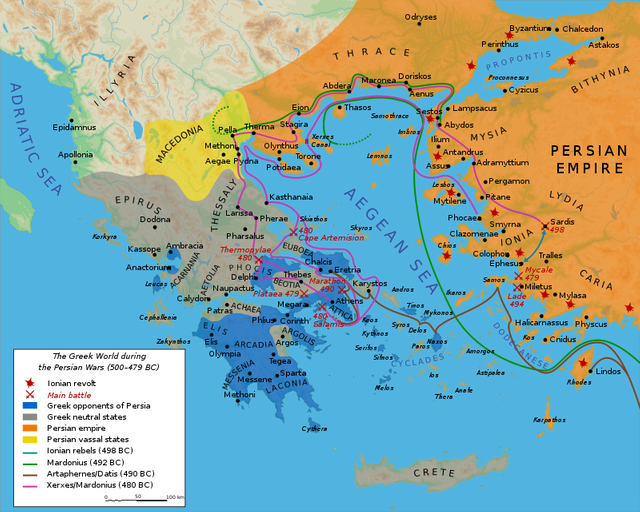
[ABOVE: The Kingdom of Macedonia (yellow) as a vassal kingdom under the Achaemenid Empire (orange), 512 - 499 BC, 492 - 479 BC]
After winning over the Paeonians, Megabazus sent a delegation of the seven highest-ranking men under himself to Macedonia to ask their king, Amyntas, for the symbol of submission: “Earth and Water”. Amyntas granted these to Darius, and then invited the Persian emissaries to dine with him, preparing a huge feast for the delegation. While Macedonians typically separated their men from their women at such events, they were convinced to do otherwise by their new “masters”. The women were ordered to sit opposite the Persian men, who approached them and began to grope them. Amyntas held back in restraint, but his young son Alexander I - no not THAT Alexander of Macedon - let his innocence of youth get to him. He approached his father and asked him to leave and rest while he tended to the visitors. Amyntas, however, saw what Alexander was up to, telling him to stop out of fear of his nation being destroyed down the line by Persia. However, he still took his advice and went to bed.
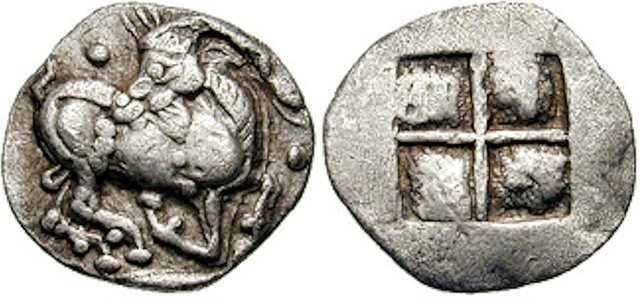
[ABOVE: Coin minted in Macedonia at the end of its independence before Persian rule, c.510 BC]
In the meantime, Alexander told the Persians that the women were theirs to do with as they pleased, however for now they were to let them go and bathe and wait for them to return afterwards. The Persian men agreed. However, the women were ordered to their own quarters instead; Alexander chose the same number of (beardless) men as there were women and had them dress up like the women, arming each with a dagger. Addressing the Persian men kindly as a distraction, Alexander’s “women” were ordered to sit next to each Persian man, and when they attempted to grope them again, the daggers were drawn and the Persians, as well as their servants, were killed. Alexander covered his tracks once a search party was sent by Persia to look for the deceased emissaries, but Alexander sent bribes to Persia in the form of coinage and his own sister to distract them and help call off the search party.
DARIUS GOES TO SUSA
Megabazus took the Paeonian people across the Hellespont into Asia, and afterwards went to Sardis. By now, Histiaeus was fortifying his newly given city of Myrcinus. Megabazus expressed his disproval of allowing a cunning Greek to fortify in newly conquered lands close to his own homeland, in lands rich with resources. He requested that Darius order Histiaeus to his presence and restrain him, nulling any chance of him rallying up his local Greek population against Persia. Darius sent a message to Histiaeus:
"After thinking the matter over, I have come to the conclusion that there is no one who cares more for me and y affairs than you do; you have proved your loyalty to me by your actions, not my mere words. I have great plans for the future, and I want you here, no matter what, so that I can tell you about them."
When Histiaeus arrived in his presence, Darius told him to abandon his plans for Miletus and Myrcinus and remain by his side in Susa as an advisor and close companion. Afterwards, Darius appointed his half-brother Artaphrenes as governor of Sardis before heading back to Susa with Histiaeus. Meanwhile, Otanes, one of the original Seven Conspirators who went on to take Samos for Persia, had been made a prominent commander of the Asiatic coast, and with this command he went on to capture the cities of Byzantium (modern-day Istanbul), Chalcedon, Antandrus, Lamponium, Lemnos and Imbros, all Greek cities in and around Asia Minor. The former tyrant of Samos, Maeandrius, had his brother, Lycaretus, appointed as governor of Lemnos. An unpopular ruler there however, Lycaretus eventually died in Samos.
THE IONIANS
The Ionians did not join in on the series of rebellions occurring during Darius’s reign, however come the year 499 BC, when an expedition to the island of Naxos was to take place, the Ionians deposed of their tyrants and begun a revolt. Cities from the Hellespont to the south of Asia Minor and even Cyprus would raise cities in rebellion too.
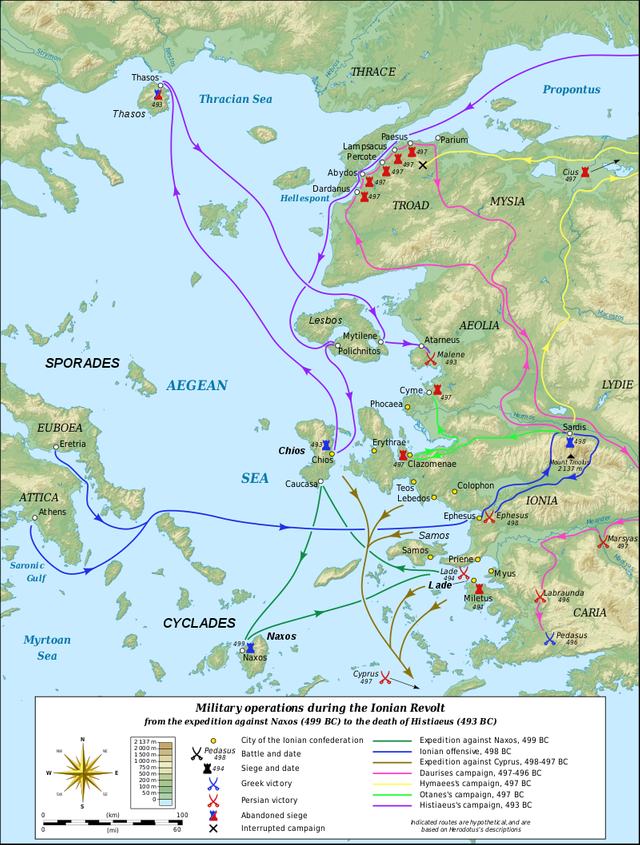
[ABOVE: Map of the Ionian Revolt, 499 - 493 BC]
This rebellion, known as the Ionian Revolt, would spill into the Greek world; The Ionians would receive help from the newly-democratic nation of Athens and her allies, and the infamous wars to come would shape the world forever. Here starts the Greco-Persian Wars.
Stay tuned.
SOURCES
• Herodotus's "Histories"
• National Geographic's "The Most Influential Figures of Ancient History"
• Nic Fields' "Thermopylae 480 BC, Last Stand of the 300"
• Oswyn Murray's "Early Greece"
YOUTUBE LINK
(I do NOT own this video)
"DARIUS THE GREAT - PERSIA RISES PART 3 - ACHAEMENID PERSIAN HISTORY", by "Yore History"
This has been the eighth part in many blogs on the Achaemenid Empire. Go and check out the rest if you haven't already:
THE PERSIAN EMPIRE
https://steemit.com/hive-133974/@oo7harv/the-persian-empire-history-s-first-superpower
CYRUS THE GREAT 1
https://steemit.com/hive-133974/@oo7harv/cyrus-the-great-conquests-of-media-and-lydia
CYRUS THE GREAT 2
https://steemit.com/hive-133974/@oo7harv/cyrus-the-great-2-conquest-of-babylon-and-his-downfall
CAMBYSES II
https://steemit.com/hive-133974/@oo7harv/cambyses-ii-heir-to-cyrus-the-great-530-522-bc-part-1
CAMBYSES II 2
https://steemit.com/hive-133974/@oo7harv/cambyses-ii-the-mad-persian-shah-530-522-bc-part-2
CONSPIRACY OF THE 7
https://steemit.com/hive-133974/@oo7harv/the-conspiracy-of-the-seven-from-cambyses-to-darius
DARIUS THE GREAT 1
https://steemit.com/hive-133974/@oo7harv/darius-the-great-part-i-administrating-an-empire
PERSIAN PROVERBS
https://steemit.com/quotes/@oo7harv/persian-proverbs
THE HISTORY COMMUNITY
https://steemit.com/created/hive-133974
All feedback - positive and/or critical - is appreciated!
Don't forget to rate this post and leave a tip if you enjoyed it
Thanks for reading :)